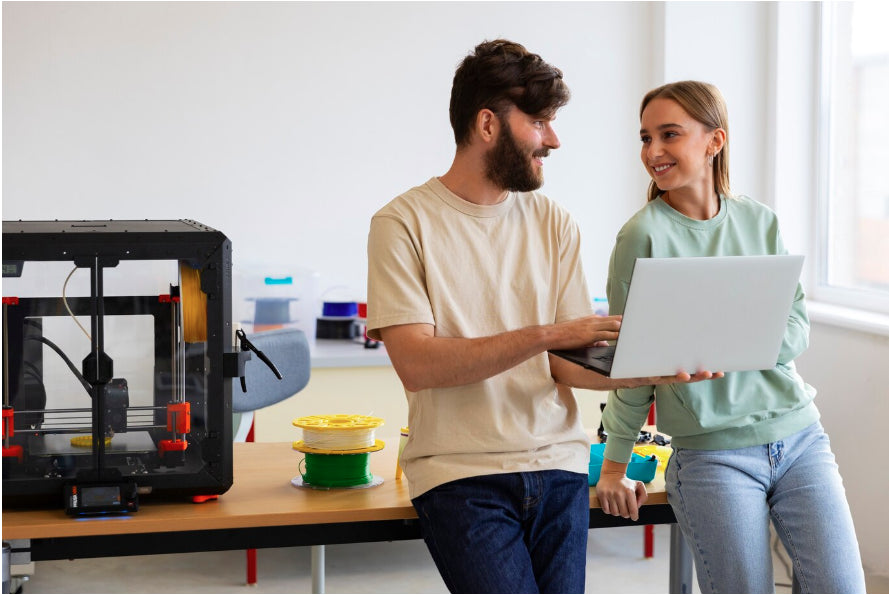One technological advancement that exemplifies ingenuity and versatility is 3D printing. The space of assembling and prototyping is never-ending developing, and 3D printing stands apart as an innovation that represents this. Diverse methodologies have piqued the interest of both engineers and designers. Their attention has been captivated by these techniques. Modern manufacturing techniques for three-dimensional printing, particularly the utilisation of multiple materials in the printing process, have created novel prospects. By means of this essay, my objective is to explore the complex realm of multi-material 3D printing, analyse the substantial role that supports assume and discuss the distinctive attributes of various printing materials, including carbon fibre, resin, and PETG.
The Advent of Multi-Material 3D Printing:
The execution of multi-material 3D printing addresses a significant headway in the movement of added substance producing innovation. This accomplishment signifies a critical advancement. In contrast to the one-material constraints of conventional 3D printing methods, multi-material printing permits the utilisation of numerous substances concurrently during a single print cycle. This stands in opposition to traditional 3D manufacturing methodologies. This skill enhances not only the functional characteristics but also the aesthetic appeal of the printed items. Consider a hypothetical situation wherein a composite part with rigid interiors and malleable exteriors can be printed in a single pass. This situation would certainly captivate your imagination. An instance of the captivating applications that can be discovered in this field is the development of complex consumer products. Another instance pertains to the advancement of state-of-the-art medical apparatus.
Support Structures: Unsung Heroes of 3D Printing
However, despite their frequent necessity in the 3D printing process, support structures receive inadequate industry attention. Temporary scaffoldings are utilised during the printing process to provide support for objects that protrude beyond the page's boundary and intricate geometries. This ensures not only the prevention of deformations but also the preservation of the integrity of the final product throughout the process. Achieving an optimal equilibrium between delivering suitable assistance and necessitating minimal post-processing labour is what renders the design of support structures a nuanced discipline. Because it necessitates a balance between the two concepts. Further simplification of this facet of 3D printing has been achieved due to advancements in soluble support materials. These advancements have enabled the attainment of cleaner breakaways and decreased the quantity of labour necessary for post-processing.
Spotlight on Printing Materials:
Material selection during the entirety of the three-dimensional printing (or 3D fabrication) procedure has a substantial impact on the characteristics of the end product. To commence, let us examine a selection of the most promising materials presently available in the marketplace:
Carbon Fiber 3D Printing Material:
When lightweight construction and resilience are essential, carbon fibre is the ideal material to use. Carbon fiber 3d printing material is an optimal substance for these applications on account of its well-known rigidity and strength. It enjoys significant popularity in sectors such as aerospace and automobile manufacturing, where efficacy and efficiency are paramount.
Resin Material for 3D Printing:
Resin is an optimal material for the fabrication of intricate jewellery, models, and art objects due to its capacity to impart flawless surfaces and a remarkable degree of detail. It is currently more versatile than ever before due to recent enhancements that have increased its durability.
PETG: 3D Printing Material
PETG 3d printing material, which achieves a commendable equilibrium between strength and flexibility and is user-friendly, is an outstanding alternative that both enthusiasts and experts will give due consideration. Due to the amalgamation of these two characteristics, it is viable for an extensive array of applications. Due to its combination of ABS strength and PLA dependability, it is suitable for an extensive range of applications.
Materials for Resin 3D Printing in Australia:
From a geographical standpoint, Australia has experienced an expansion in the accessibility of Resin 3D printing materials Australia, including a diverse range of such materials. This is an occurrence that has been noted. This growth is currently being propelled by the expanding demand for adaptable, high-quality solutions that span various sectors, such as consumer electronics and healthcare. Cutting-edge resin materials are being utilised more frequently by both professional and amateur manufacturers in Australia to expand the limits of what can be accomplished through 3D printing.
Conclusion:
Certain organisations, including 3D Meta, are leading the way in this revolutionary movement. They provide state-of-the-art materials and solutions that cater to a diverse array of sectors and specifications. Such organisations are leading the way as we further examine and investigate the capabilities of three-dimensional printing material. Whether you are an accomplished engineer seeking to incorporate multi-material printing into your projects or a designer eager to explore novel supports and inventive materials, we serve as the definitive resource for all things pertaining to 3D printing.


